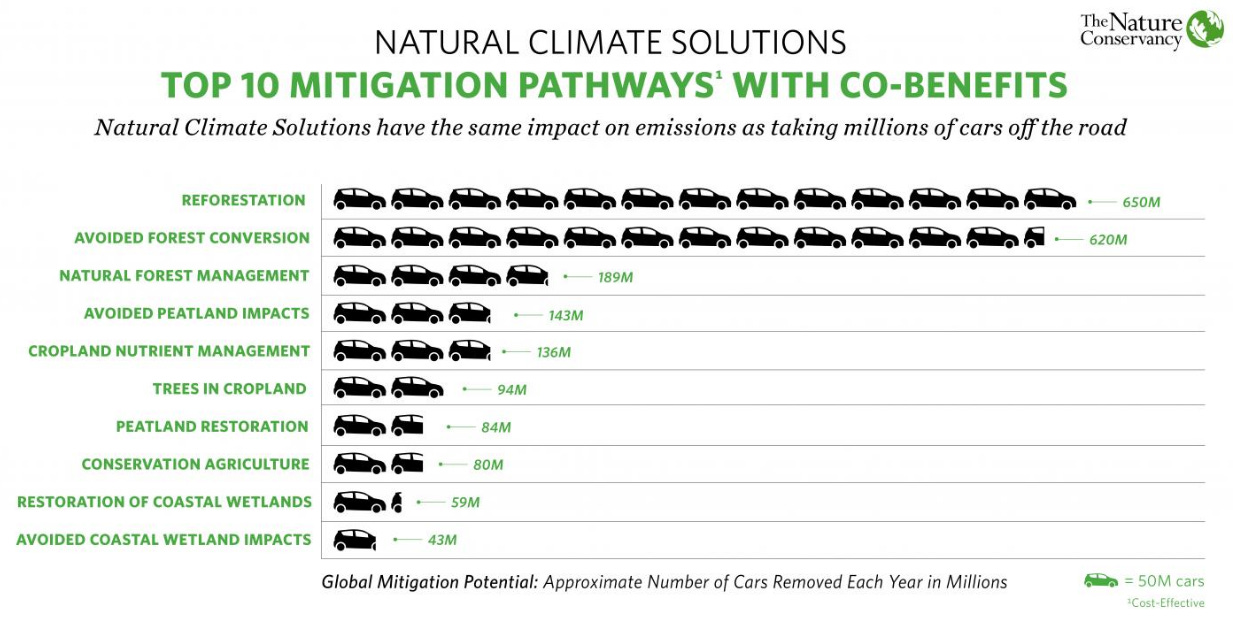The Nature Conservancy is wrong. Planting trees is not equivalent to halting the burning of oil
Here we go again. “Plant more trees to combat climate change: scientists” is a Reuters headline from earlier this week. The article is based on a press release put out by The Nature Conservancy about a paper published in the journal Proceedings of the National Academy of Sciences. The paper’s argument relies on the scientific fraud that the carbon stored in forests, soil, and landscapes is climatically the same as the carbon stored underground in fossil fuels.
The paper is titled “Natural Climate Solutions”. It starts as follows:
The Paris Climate Agreement declared a commitment to hold “the increase in the global average temperature to well below 2 °C above preindustrial levels”. Most Intergovernmental Panel on Climate Change (IPCC) scenarios consistent with limiting warming to below 2 °C assume large-scale use of carbon dioxide removal methods, in addition to reductions in greenhouse gas emissions from human activities such as burning fossil fuels and land use activities. The most mature carbon dioxide removal method is improved land stewardship, yet confusion persists about the specific set of actions that should be taken to both increase sinks with improved land stewardship and reduce emissions from land use activities.
The paper looks at “20 conservation, restoration, and/or improved land management actions that increase carbon storage and/or avoid greenhouse gas emissions across global forests, wetlands, grasslands, and agricultural lands”.
Planting trees is not the same as leaving fossil fuels underground
The Nature Conservancy’s press release states that, “natural climate solutions could reduce emissions by 11.3 billion tonnes per year by 2030 — equivalent to halting the burning of oil.”
The Nature Conservancy claims in its press release, that reforestation, avoiding forest loss, and better forestry practices “could cost-effectively remove 7 billion tonnes of carbon dioxide annually by 2030, equivalent to taking 1.5 billion gasoline-burning cars off the roads”.
The Nature Conservancy’s press release and graphic reinforces the scientific fraud that the paper relies on – that carbon stored above ground in ecosystems is climatically the same as that stored below ground as fossil fuels. But while the two are chemically identical, in terms of their influence on climate change they are completely different.
Carbon stored in fossil fuels below the earth’s surface is stable. Unless corporations dig it out and burn it, the carbon does not enter the atmosphere. Fossil fuels have safely stored carbon below ground for millions of years.
Carbon stored in ecosystems is not stable. Forests can catch fire. They can be destroyed by pests. They can be logged, flooded to created reservoirs, removed to make way for mines, cattle ranches, or industrial plantations of soy, palm oil, or pulpwood. The carbon stored in ecosystems is only stored temporarily.
This year, California has seen its most deadly forest fires ever. In Portugal and Spain, forest fires have killed 35 people.
In September 2017, there were 110,736 fires in Brazil. That’s a record. It’s more than in any previous month in the 20 years that Brazil’s National Institute of Space Research (INPE) has been recording fires.
When trees, forests, and plantations go up in smoke the carbon stored in them enters the atmosphere.
Peer review?
How did such a blatant scientific fraud get published in a peer reviewed journal? Easy. The reviewers were Jason Funk and Will Turner. Funk works at an outfit called Center for Carbon Removal that works to “clean up carbon pollution from the air”.
Will Turner works for Conservation International. Despite the overwhelming evidence that REDD is not succeeding in protecting tropical rainforests (including in Conservation International’s own REDD projects), Conservation International remains a vocal proponent of REDD.
Clearly neither Funk not Turner is going to be very critical of an academic paper proposing “Natural Climate Solutions” as a way of addressing climate change.
The trouble with negative emissions
The paper in the Proceedings of the National Academy of Sciences is part of a long running theme in the climate negotiations. British climate scientist Kevin Anderson calls it “Plan B”, and it has been developed by well-meaning scientists, engineers, environmentalists, and economists. Plan B is based on the concern that governments and corporations will fail to reduce emissions from oil, gas, and coal.
Shortly after the Paris Agreement was finalised in December 2015, Anderson wrote,
If we choose to continue our love affair with oil, coal and gas, loading the atmosphere with evermore carbon dioxide, then at some later date when sense prevails, we’ll be forced to attempt sucking our carbon back out of the atmosphere.
“Negative emissions technology” is the term used for sucking carbon out of the atmosphere, or in The Nature Conservancy’s greenwashed version, “Natural Climate Solutions”. The danger of focusing on this “Plan B” is that it distracts from the urgent need to leave fossil fuels underground. In September 2017, Anderson gave a lecture at the Royal Swedish Academy of Sciences titled, “Mitigation on methadone: The trouble with negative emissions”.
In the lecture, Anderson describes how inadequate our response to the threat of climate change has been, and the dangers of focusing on negative emissions to address climate change.
The PNAS paper does mention the importance of “simultaneous implementation of mitigation from both NCS [Natural Climate Solutions] and fossil fuel emissions reductions”. The paper states,
Given the magnitude of fossil fuel emissions reductions required under any <2°C scenario, and the risk of relying heavily on negative emissions technologies (NETs) that remain decades from maturity, immediate action on NCS should not delay action on fossil fuel emissions reductions or investments in NETs.
But the paper focuses on negative emissions technology, not on reducing emissions from fossil fuels.
The Nature Conservancy’s focus on “natural climate solutions” is yet another dangerous distraction from the urgent need to find ways of leaving fossil fuels underground.







